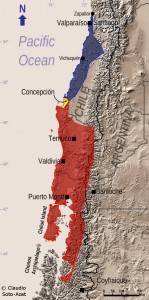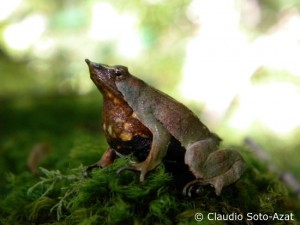Former EDGE fellow Claudio Soto-Azat has recently published a paper on the conservation of Darwin’s frogs, which includes the northern Darwin’s frog (Rhinoderma rufum) – EDGE amphibian 45. The work carried out as part of his fellowship programme and his PhD at the Universidad Andres Bello in Chile has revealed that the species may no longer exist.
Whilst there are numerous species named after the English naturalist Charles Darwin, two of the most incredible are frogs found in Chile and Argentina. The northern (Rhinoderma rufum) and the southern Darwin’s frog (Rhinoderma darwinii) are unique amongst all other amphibians as they are the only species where the males incubate the eggs of their young in their vocal pouch. These species are incredibly unique and also extremely endangered. As the northern Darwin’s frog is listed as critically endangered it was calculated to be EDGE amphibian number 45. Recent research by an EDGE fellow revealed that Rhinoderma rufum might actually be extinct.
The work was carried out by Claudio Soto-Azat, and his collaborators (including Andrew Cunningham and Marcus Rowcliffe from ZSL) and published last week in the journal PLoS ONE as part of his two year EDGE fellowship programme and his PhD on the temperate forests of South America. By using museum specimens and records it was possible to develop historical distribution maps for both species. Surveys were then carried out to understand the current populations and change in distribution. Whilst the southern Darwin’s frog was found in only 36 sites in Chile and Argentina, its northern sister species was never sighted.

As the northern Darwin’s frog has not been sighted since October 1980 the authors of the paper suggest that it is probably extinct – they go on to state that based on modelling it is likely to have gone extinct in 1982. Hope remains that a small population of R. rufum still exist based on the vast historical distribution of the species in the past. Therefore it is suggested that the species retains its red list IUCN status of Critically Endangered, but to be tagged with the Possibly Extinct subcategory. It is also proposed that R. darwinii should be reclassified from Vulnerable to Endangered as remaining populations are very small and severely fragmented. We hope this information is considered when the next IUCN conservation assessment takes place.
If the northern Darwin’s frog is extinct it would represent a huge loss in genetic diversity and their unique reproductive behaviour will be lost forever. “The EDGE programme and the Institute of Zoology, Zoological Society of London, have been the most important support I have had to carry out my research. Not only due to funding, but also since the important contribution of ZSL scientists and conservation specialists this study was possible”, says Claudio Soto. This highlights the importance of the EDGE of existence programme and the work carried out by EDGE fellows.
The paper published in PLoS One is available here.
Read more about EDGE fellows here.
